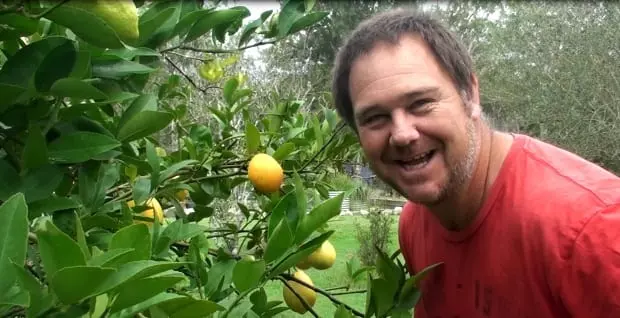If you want an easy, no fuss, fruit tree to grow, then the Meyer lemon tree would have to be without a doubt in the top ten list. No matter if your gardening skills stink you will be able to grow this tree and produce one of the most famous and popular fruit known to humanity – lemons.
Also, because the Meyer lemon tree is such a prolific fruiter you’ll have plenty of fruit to use for all your kitchen needs and then some left over to make an amazing jam/marmalade. The beauty of the Meyer lemon is its flavour, being a cross between an orange and a lemon (but more lemon than orange) the fruit from this tree goes well when you want an acidic hit on a savoury dish or when made into a sweet marmalade.

Yours truly with my Meyer lemon tree (image above)
I have made a video (at the end of this post) detailing my Meyer lemon marmalade recipe from beginning to end so I won’t bore your eyes by writing a whole lot of dribble when you can just simply watch it (please ignore my acting ability).
Growing tips
Generally, growing this variety of lemon is a cinch and it will grow in a range of climates from cool to hot as long as appropriate measures are taken in the extremes. Covering and protecting the tree during heavy frosts or long dry spells with plenty of water is needed particularly for young trees.
The Meyer lemon is the fastest growing lemon out of two other varieties I have being the Eureka and Lisbon. Fast growing may not be a big plus for some people but for me I do like tree that can adapt and grow quickly so I can minimise nursing ASAP and know they will be ready for anything our tough climate can throw at it. I have a lot to do on my property and I certainly don’t have the time to “baby” a fruit tree for years and that’s why a large number of my trees are citrus.

Mature Meyer lemon tree in full fruit (image above)
Yes citrus are hardy and the Meyer lemon is no exception but there are several measures people can take to get the best out of their Meyer lemon tree and below are a few extra tips to ensure the tree grows well and produces good quality fruit.
Soil and Location – Try and find a good spot on high ground away from depressions with a good quality free draining soil. If the soil is heavy (like clay) don’t worry too much as the Meyer lemon will grow quite happily as long as there is a small amount of good topsoil.
If topsoil is lacking then improve the local area and planting hole with compost/well-rotted manures and bring in other soil (if necessary) to get the tree off to a good start.
If you’re worried about size don’t be because the Meyer lemon is not a very intrusive tree and won’t get above 5 metres tall. Actually, it will likely stay around 3 metres or less but it can always be kept in check by pruning back anyway.
Mulching – Along with soil and location using a good amount of mulch around the tree will help it dramatically. Citrus have lots of feeder roots close to the surface and they are very important for instant water harvest and nutrient take-up, therefore, covering these roots via a nice thick mulch will protect the tree from weather extremes, help it take-up water and nutrients, and suppress weeds.
Fertiliser and trace elements – A good citrus fertiliser usually has trace elements included but if you are like me and use a lot of natural fertiliser in the garden like (poultry manure) the tree may not get all of the minerals it needs to flourish.
This is particularly evident in heavy soils where the nutrients and minerals can sometimes be difficult for the tree to absorb. Some trace elements dissolved and watered around the base of the tree can do wonders for a lemon tree and keep it healthy. Make no mistake, the Meyer lemon is a hungry tree because it is such a great producer and grower.
Pruning – I prune my Meyer lemon once a year after the main fruiting (I say “main” because my tree is always in fruit). The idea behind pruning my lemon trees is to get rid of crisscrossing branches, dead wood, and branches which are drooping too low around the base of the tree. Pruning enhances growth and opens the tree up to better airflow and this in turn helps prevent diseases or pest build-ups.
Use sharp tools when pruning to minimise the risk of infection.

An example of the sheer weight of fruit pulling a branch down to ground – amazing! (image above)
Fruit – As I mentioned, our Meyer lemon tree is continuously in fruit and flower and I know it does sound a little over stated but I can’t recall a time in the past 8 years when our tree didn’t have fruit on it, besides when it was in its first year.
Even then, it fruited and that brings up a good point about de-fruiting when the tree is young. There is a common point of view that fruit trees should be de-fruited during the first few years so that the tree puts its energy into growing strong rather than producing fruit. However, I differ slightly and don’t see any harm in leaving a few fruit on a newly planted tree.
Naturally, if the small tree has several fruit than I would recommend picking most of them off but a few left on won’t hurt and I’ve seen no evidence of retarded growth due to leaving a small quantity fruit on a young tree, likewise I’ve seen no significant gains by removing all the fruit (which I have done many times before also).
As far as the fruit goes, the Meyer lemon is large and not overly seedy either, which is nice. Personally, I can’t rave on enough about its eating qualities and although it technically is crossed with an orange, I reckon it’s the best lemon.
Water – I’ve stated how hungry Meyer lemon trees are and they are also thirsty! This doesn’t mean they need to be watered every day but an established tree will need a really good soak and drinking at least once a week.
Sometimes it isn’t easy to keep the water up and Meyer lemons will cope with dry spells; however, it will take its toll on the fruit with a smaller sized end product and/or a more concentrated flavour. A water deprived Meyer lemon can even have dry fruit of such poor quality they aren’t worth eating and that’s a real waste for a tree to still produce fruit that can’t be used when a simple watering plan can make all the difference.
Pests, diseases, deficiencies – If the Meyer lemon tree is kept healthy it is rarely infested with pests or severe disease. The most common problem I see with lemon trees is mineral deficiencies where a yellowing or prominent veiny appearance on the leaves is a dead set give away. A good dose of fertiliser and trace elements should fix this up within several weeks.
Aphids, citrus bugs (like bronze orange bug), citrus bud mite (deforms fruit), caterpillars, scale, gall wasp (where the stem swells in places), are all easy to control on a healthy tree by either manually removing or spraying with a natural low toxic remedy such as pest oil etc.
Honestly, I leave most pests on my trees and let the good guys (insects) get them. If an infestation breaks out I monitor the tree and if it is obvious the tree is in trouble, and the “good guys” are too busy, I may then spray with an organic remedy but usually I’ll just spend the time picking them off by hand.
Video
Here’s the video I made about the Meyer lemon tree and how to make the most wonderful Meyer lemon marmalade or jam you could ever want to eat!
Conclusion
They say, every backyard should have a lemon tree and I think so too but make it a Meyer lemon! Pound for pound it will save money and earn its keep well within just a few years of planting – hell, you might even make money out of it by selling the jam or fruit because you’ll have plenty of it.
This is an amazing fruit tree and I rate it among the best and most valuable and most used trees in my garden… I’m not kidding.
If you would like to ask a question or say something about this post you can make a comment below, or join our forum and post your own question/POV in the fruit growing section, or even comment on the video itself via YouTube.
Mark Valencia – Editor SSM
Look, and see the Earth through her eyes…












